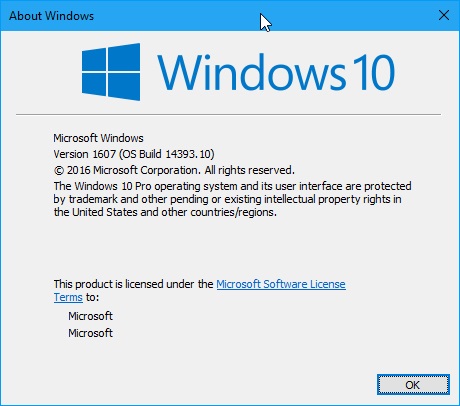Microsoft extends support of Windows 10 version 1607 to 2023
Microsoft confirmed to Zdnet yesterday that it will support PCs with Intel's Clover Trail processor with security updates until 2023.
We revealed on Tuesday that devices with Intel Clover Trail processors cannot be upgraded from an earlier version of Windows 10 to the Creators Update version of the operating system (or any future update like the Fall Creators Update).
The error message Windows 10 is no longer supported on this PC is displayed during the upgrade process, and there does not seem to be a way around this.
This is the first time that devices are blocked from receiving new Windows 10 feature upgrades, and it could not come at a worse point in time.
Clover Trail is not a particularly old technology, as it came on the market powering Windows 8 devices. These devices were upgraded to Windows 8.1 when it was released. We are talking about devices that are three to five years old, not something ancient.
Microsoft ran the Get Windows 10 campaign, and many of the devices were upgraded to Windows 10 for free during that time period.
The main issue for users of these devices is that the device would have been supported until 2023 if Windows 8.1 was still the operating system of choice. With Windows 10's Anniversary Update and the inability to upgrade to a newer feature update, support would run out in 2018.
That is bad, especially if you were a victim of the Get Windows 10 campaign that at times was quite aggressive in moving users from the older operating system to the newer one.
Microsoft extends support

Microsoft confirmed to ZDnet that Windows 10 systems running Intel Clover Trail cpus are stuck on the Anniversary Update version of Windows 10, and that there won't be a fix for that which allows these devices to be upgraded to newer feature update versions of Windows 10.
In a surprise turn of events, Microsoft has a solution for affected devices. While feature updates won't be offered to these devices anymore, Microsoft will provide them with security patches until 2023.
To keep our customers secure, we will provide security updates to these specific devices running the Windows 10 Anniversary Update until January of 2023, which aligns with the original Windows 8.1 extended support period.
Basically, what that means is that Microsoft breaks the Windows as a Service model which has feature updates supported for 18 months only before they are no longer supported (with the exception of Windows 10 Enterprise LTSB devices).
The reason why Microsoft plans to provide patches until 2023 is simple: this is the year in which support for Windows 8.1 runs out.
Microsoft blames Intel for the support snafu:
This is the case with devices utilizing Intel Clover Trail Atom Processors1 today: they require additional hardware support to provide the best possible experience when updating to the latest Windows 10 feature update, the Windows 10 Creators Update. However, these systems are no longer supported by Intel (End of Interactive Support), and without the necessary driver support, they may be incapable of moving to the Windows 10 Creators Update without a potential performance impact.
Closing Words
This incident is important because of two things. First, and that is probably the important one, that the support period of Windows 10 and a device running the operating system may not overlap. If a hardware partner decides to end support for a particular component, users may be stuck on a version of Windows 10 that they cannot upgrade anymore.
The only recourse then is to either hope that Microsoft will provide security updates for these devices as well, or to install another operating system on the device.
Microsoft stepped in this time, but will the company do so for future incidents as well? This would torpedo the company's Windows as a Service model, as it would have to produce security updates for then unsupported versions of Windows 10.
Microsoft breaks its own Windows as a Service model when it starts to support versions of Windows that are at the end of their support cycle.
I think Microsoft does the right thing here. While it could have put the blame solely on Intel ignoring the situation that Clover Trail customers are in, it made the decision to break its own servicing model.
Now You:
This article was first seen on ComTek's "TekBits" Technology News

- Log in to post comments